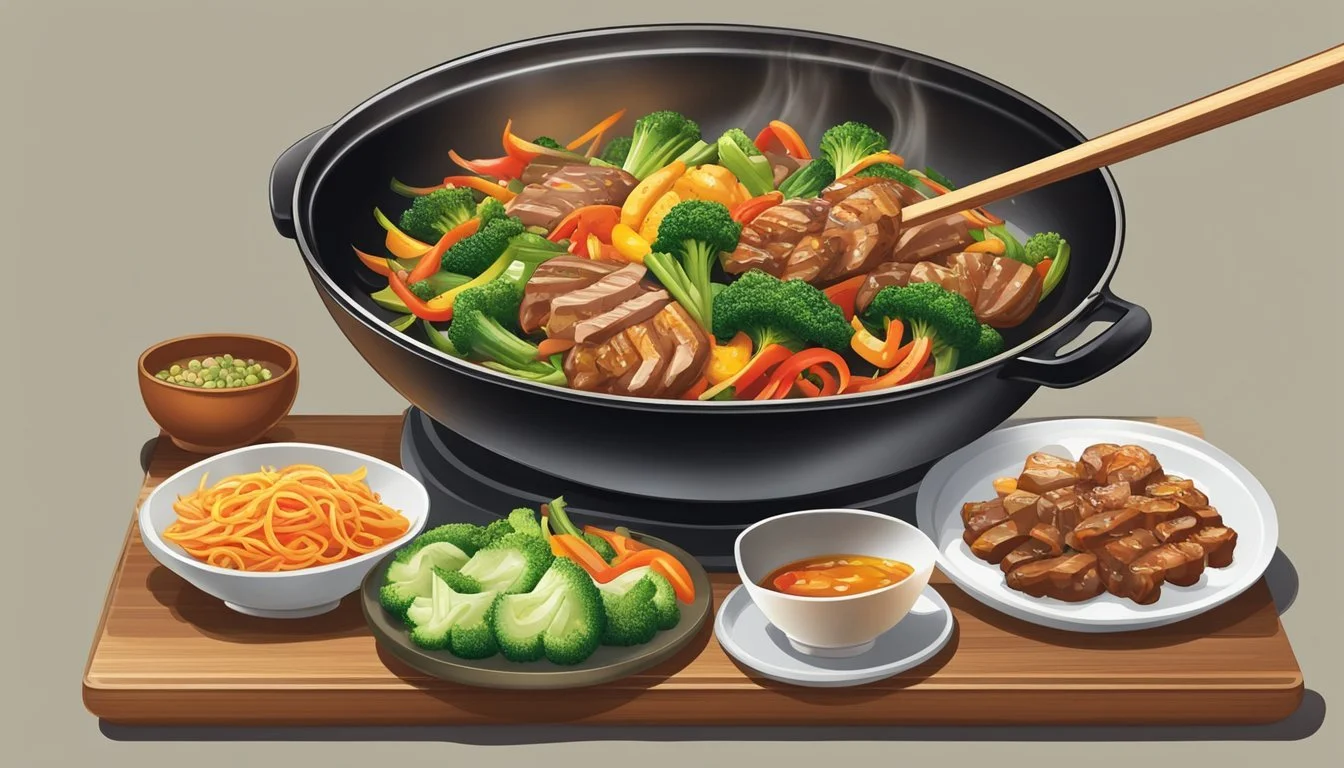How to Cook with Kikkoman Soy Sauce
Unlocking Authentic Asian Flavors
Kikkoman soy sauce is a staple condiment that has been integral to Japanese cuisine for generations. It is crafted traditionally from a blend of soybeans, wheat, salt, and water, and the mixture is fermented, then aged to develop its complex, rich flavor that's unmistakably umami with a hint of sweetness. This versatile condiment enhances not only Japanese dishes but also a vast array of Asian cooking, providing that authentic taste cherished around the globe.
When cooking with Kikkoman soy sauce, it is embraced as more than just a seasoning. It becomes a key ingredient that brings out the natural flavors of ingredients without overpowering them. Whether used in marinades to tenderize and infuse meats with succulence or as a dipping sauce that complements and contrasts flavors, Kikkoman soy sauce is a testament to both tradition and the unifying power of culinary culture across Asian cuisines.
Understanding how to incorporate Kikkoman soy sauce can transform simple dishes into authentic Asian culinary experiences. Utilizing proper techniques such as stir-frying, brining, and glazing with Kikkoman can elevate the flavor profiles of meals, making it a necessary addition to the kitchen pantry for anyone looking to recreate the essence of Asian flavors within their cooking.
The History and Origin of Kikkoman Soy Sauce
Kikkoman is synonymous with soy sauce, having established a global reputation for its authentic and traditionally brewed product. The company's inception can be traced back to the 17th century, where it originated in the small town of Noda, a location well-suited for soy sauce production due to the presence of the Edo River and its conducive climate.
The soy sauce that Kikkoman is famed for is naturally brewed, a process steeped in history and tradition. This method involves a meticulous fermentation process combining soybeans, wheat, salt, and water. Fermentation, the core of Kikkoman's brewing process, allows the soy sauce to develop its complex flavors and rich aroma over several months, following practices that have been handed down and refined over centuries.
Notable Milestones for Kikkoman:
1917: Formation in Noda by a collective of family-run businesses.
1957: Opened the first overseas sales office in San Francisco.
1972: The inauguration of its first production plant outside Japan, addressing growing international demand.
Kikkoman's dedication to authenticity has ensured that their soy sauce maintains the richness and depth that consumers associate with traditional Asian cuisine. The company's adherence to age-old methods, such as fermentation and natural brewing, has been fundamental in securing their position as a staple in both home and professional kitchens around the world.
Understanding Soy Sauce Varieties
Soy sauce, an ancient condiment, is a fermented product that enhances the flavors of various dishes. The varieties available, from brewed to non-brewed to low-sodium, can significantly influence the taste and nutritional value of the meals they season.
Comparing Brewed and Non-Brewed Soy Sauce
Brewed soy sauce is a traditional preparation where soybeans and grains, often wheat, undergo fermentation with cultures and yeast. This process can span from months to years, yielding a complex, rich flavor. Non-brewed soy sauce, on the other hand, is made quickly by hydrolyzing soy proteins and combining with color, salt, and preservatives. The result is markedly different, often lacking the depth of brewed varieties.
Aspect Brewed Soy Sauce Non-Brewed Soy Sauce Flavor Rich, complex Salty, less depth Production Time Months to years Significantly shorter Main Ingredients Fermented soybeans and grains Hydrolyzed soy proteins Preservatives Fewer, if any Often contains
Low-Sodium Options and Health Benefits
Concerns over high sodium intake have led many to seek low-sodium soy sauce options. Traditional soy sauce contains significant levels of sodium, which can lead to health issues when consumed in excess. Low-sodium soy sauces are available and provide a similar flavor profile with less salt, often cutting the sodium content by nearly half.
Soy Sauce Type Approximate Sodium Content Regular Soy Sauce 900-1000mg per tablespoon Low-Sodium Soy Sauce 400-600mg per tablespoon
Manufacturers may also add preservatives to non-brewed or low-sodium soy sauces to extend shelf life. However, many brewed soy sauces are naturally preserved by their fermentation process and do not require additional preservatives.
Flavor Profile and Sensory Characteristics
Cooking with Kikkoman Soy Sauce enhances dishes with a complex flavor profile and enriches the overall sensory experience. This sauce provides a harmonious blend of the five basic flavors that are essential to many Asian cuisines.
The Five Basic Flavors
Kikkoman Soy Sauce is a powerhouse of flavor, containing all five basic tastes: sweet, sour, salty, bitter, and umami. Each tablespoon is meticulously crafted to deliver:
Sweet: A subtle hint that balances the sauce.
Sour: A mild tanginess that complements the other tastes.
Salty: The inherent saltiness that amplifies the dish's flavors.
Bitter: Just a touch, to add depth.
Umami: The rich, savory taste often associated with meats and broths, and abundant in Kikkoman Soy Sauce.
Umami and salty are the most prominent flavors in soy sauce, giving dishes a profound savoriness that is both satisfying and mouthwatering.
Soy Sauce Aroma and Taste Nuances
While the primary perception of Kikkoman Soy Sauce might be its umami and salty characteristics, the aroma plays a pivotal role in its ability to enhance food.
Aroma: Kikkoman Soy Sauce emits over 300 individual flavor and aroma components, some of which are created during the fermentation process. Its rich scent is almost caramel-like, adding a hidden layer of complexity.
Taste Nuances: Soy sauce contains a spectrum of taste nuances that it imparts to food:
Taste Quality Description Depth Adds layers of flavor beneath the initial taste. Richness Provides a hearty, satisfying sensation on the palate. Complexity Engages the palate with diverse, intricate flavors.
These characteristics make it an incredibly versatile condiment that can elevate not only Asian dishes but various Western cuisines as well.
Kikkoman Soy Sauce in the Kitchen
Kikkoman Soy Sauce serves as a versatile component in countless dishes, providing deep, rich flavors to enhance both Asian and non-Asian recipes. Its role in the culinary world spans from being a key ingredient to a subtle seasoning that can remarkably transform a dish.
Staple Ingredient in Asian Recipes
In Asian cuisine, Kikkoman Soy Sauce is paramount as an ingredient that imparts a savory flavor integral to the profile of many dishes. It is often used in marinades, where it tenderizes meats like pork chops (What wine goes well with pork chops?) while infusing them with a sweet-savory essence. Cooking tips often suggest allowing the meat to marinate for several hours to fully absorb the complex flavors.
Marinade Tip:
Ingredients: Combine 3-4 tablespoons of Kikkoman Soy Sauce per portion with other marinade components.
Ratio: Aim for a 2:1 ratio of soy sauce to other liquids for balanced flavor.
Preparation: Remember to brush off excess herbs or ingredients before cooking.
Enhancing Non-Asian Dishes
Chefs have long discovered that Kikkoman Soy Sauce is not limited to Asian dishes; it can amplify the taste of a wide variety of non-Asian recipes. Its salty flavor profile works wonders when one wants to season, brine, or add an umami punch. Experimenting with soy sauce in unexpected dishes, such as a splash in Italian pasta sauces or a teaspoon in a salad dressing, can offer a surprising savory twist.
Cooking Technique Tip:
Roasting: Baste vegetables or meats with a mix of soy sauce and olive oil to create a caramelized glaze.
Seasoning: A few drops in soups or stews can deepen the overall flavor without overpowering the main ingredients.
Creative Uses of Soy Sauce
Kikkoman soy sauce, with its rich umami character, elevates dishes from ordinary to extraordinary. It serves as a versatile component in a variety of culinary applications, infusing meals with authentic Asian flavors.
Marinades and Dressings
When creating marinades, Kikkoman soy sauce is a staple due to its ability to tenderize and imbue meat with depth of flavor. It forms a harmonious blend with ingredients like garlic, ginger, and mirin, a ratio of 2:1 soy sauce to other liquids ensures a balanced profile. For example:
Soy Sauce Brined Pork Chops: Combine Kikkoman soy sauce with mirin for a sweet-savory brine that keeps pork chops juicy.
Dressings: Whisk soy sauce with ingredients like sesame oil and rice vinegar to craft a dressing that adds a savory note to salads and cold dishes.
Dips and Sauces
The use of Kikkoman soy sauce in dips turns ordinary snacks into flavorful experiences. A simple sauce with soy sauce, garlic, sugar, and lime can create a sweet and tangy dip, perfect for spring rolls or dumplings. The ratio of soy sauce to fatty components like sesame paste or mayonnaise can be adjusted to taste, often starting at a 2:1 ratio favoring soy sauce.
Peanut Dipping Sauce: Ideal for satays or fresh rolls, this sauce combines the umami of soy sauce with the crunch of peanuts.
Seasoning and Finishing Touches
As a seasoning, Kikkoman soy sauce can provide the final flavor adjustment to dishes such as stir-fries and noodle soups. Small amounts can enhance the natural flavors of ingredients and add a rich color to the dish. It's important to add soy sauce during the final stages of cooking to avoid diminishing its flavor.
Injecting Flavor: Use soy sauce judiciously to adjust seasoning in cooked dishes, ensuring a balance between salty and savory elements without overpowering the dish.
Color: Beyond taste, soy sauce imparts a desirable golden-brown hue, enhancing the visual appeal of the finished meal.
Tips and Techniques for Cooking with Soy Sauce
Kikkoman soy sauce offers a versatile way to add depth and authenticity to Asian-inspired dishes. This section will explore ways to effectively integrate soy sauce into your cooking repertoire, focusing on flavor balance, marinating, and even unconventional uses like baking.
Balancing Flavors and Sodium Content
When cooking with soy sauce, it's crucial to balance the saltiness it brings to the dish. A common technique is to start with a modest amount and taste as you go, since its sodium content can easily overpower other flavors. For those looking to reduce sodium intake, Kikkoman offers a low-sodium variant that can be substituted in any recipe.
Tip: Use a 2:1 ratio of soy sauce to other liquids like water or broth to maintain flavor without excessive saltiness.
Vegetables: They can absorb soy sauce quickly, so brief cooking times are recommended to prevent them from becoming too salty.
Marinating and Grilling with Soy Sauce
Soy sauce is an excellent base for marinades, as its properties help to tenderize meat while imparting a rich, umami flavor. For grilling, marinate proteins for several hours — or even overnight for meat cuts — to ensure the flavor penetrates sufficiently.
Marinating Tip: Combine soy sauce with ingredients like garlic, ginger, and sesame oil for a flavorful marinade.
Grilling Tip: It's important to brush off any herbs or solid ingredients from the food before grilling to prevent burning.
Adding Soy Sauce to Baked Goods
Incorporating soy sauce into baked goods might initially seem unorthodox, but it can enhance the flavor profile of savory items. The key is using small amounts to avoid overwhelming the other ingredients.
Savory Pastries: Add a teaspoon of soy sauce to dough or fillings for an added depth of flavor.
Breads: A dash of soy sauce can intensify the taste of homemade breads without imparting a soy sauce flavor when used sparingly.
Pairing Soy Sauce with Ingredients
Kikkoman Soy Sauce's rich umami flavor pairs well with a variety of ingredients, enhancing both sweet and savory dishes. The right pairings elevate the overall taste and bring authenticity to Asian cuisine.
Complementary Flavors and Spices
Garlic and Ginger: These aromatics blend perfectly with soy sauce, offering a warming and slightly spicy undertone that complements meat dishes.
Spices: Mild spices like star anise and cinnamon can be balanced with the boldness of soy sauce in braised dishes (What wine goes well with braised dishes?).
Soy Sauce with Fruits and Sweets
Fruits: Citrus fruits like orange and lemon work well with soy sauce to create a sweet and tangy glaze for proteins.
Sweetener: A hint of sweetness such as honey or sugar can counterbalance the saltiness of soy sauce, especially in marinades and dressings.
Vegetables and Soy Sauce Combos
Leafy Greens: Soy sauce can bring out the earthy flavors of vegetables like spinach and bok choy.
Starchy Vegetables: Root vegetables such as carrots and potatoes can absorb the savory notes of soy sauce, making them more flavorful when roasted or stir-fried.
Grocery and Brand Guide
When selecting soy sauce for cooking authentic Asian dishes, one's choice in products matters. Choose a brand and type that will best enhance your culinary creations.
Selecting the Right Kikkoman Product
Kikkoman offers a variety of soy sauces, each tailored for specific uses. Naturally brewed over months, these sauces provide depth and richness. The Kikkoman Soy Sauce, standard and versatile, is an excellent all-purpose seasoning. For those watching their sodium intake, Kikkoman also produces a Less Sodium Soy Sauce. It is important to match the product to the dish for optimal flavor.
Comparing Brands: Kikkoman vs. Others
Kikkoman, a leading brand in the soy sauce market, often stands out against competitors like Yamasa. While both are known for their quality, Kikkoman's naturally brewed process ensures a complex flavor profile without added preservatives. On the other hand, Yamasa also has a revered method for producing its Shoyu—a term synonymous with soy sauce. Consumers should note taste and consistency differences among brands to find their preference.
Label Reading and Product Selection
It's essential to read labels carefully to understand what's in your soy sauce. Look for keywords like "naturally brewed," which indicates a traditional method of production resulting in a more nuanced taste. Avoid products with a long list of preservatives or additives. Kikkoman products, for instance, highlight their pure ingredients: soybeans, wheat, salt, and water. This commitment to simplicity often sets them apart in the marketplace.
Conclusion
Kikkoman soy sauce, a staple in Asian cuisine, offers cooks a gateway to the authentic flavors inherent in Japanese food. (What wine goes well with Japanese food?) Its versatility in cooking is unparalleled, enhancing dishes with its rich, umami qualities.
Ingredients Harmony: In Asian recipes, Kikkoman seamlessly blends with ingredients such as garlic, ginger, and rice vinegar, achieving a harmonious balance of flavors.
Marinades and Glazes: When used as a marinade, Kikkoman soy sauce infuses meat with deep flavor while acting as a tenderizer. As a glaze, it delivers a glossy, flavorful finish that complements the textures of vegetables and proteins.
Culinary Techniques:
Stir-Frying: Just a splash can transform a simple stir-fry into a complex flavor experience.
Braising: Its deep flavor profile enriches slow-cooked dishes.
Dipping Sauces: Whether mixed with citrus or chili for a robust dipping sauce, it contributes nuanced character to any meal.
In summary, Kikkoman soy sauce is a key ingredient for chefs looking to impart authentic Asian flavors into their cooking. Its application goes beyond just a condiment and enters the realm of culinary essentials, an indispensable addition to any kitchen aiming to explore the rich tapestry of flavors that Japanese cuisine offers. As they continue their culinary journey, cooks will find Kikkoman to be a reliable and essential partner in the creation of delectable dishes.






